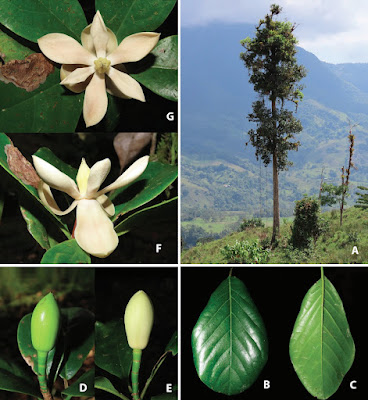 |
| Magnolia pajarito Aymard, Rodríguez-D. & M. Escobar., in Rodríguez-Duque, Escobar-Alba, García-González, Carvajal-Cogollo et Aymard-Corredor, 2022. Harvard Papers in Botany. HUH.harvard.edu |
Abstract
Magnolia pajarito, a new species from the Andean slopes of the Eastern Cordillera of Colombia, is described and illustrated, and its morphological relationships with other similar Magnolia species are discussed. This new species is a tree between 9 and 30 m tall from montane forest remnants and pasture lands with dispersal trees (1500–1700 m), and it does not appear to be closely allied to any particular Magnolia species. This new species shares several features with four other species (M. arcabucoana, M. caricifragans, M. santanderiana, and M. virolinensis) in section Talauma. Morphologically it has some similarity to M. arcabucoana, but it differs in the length of the adaxial scar of the petiole, the size and shape of the leaf blade, the sepal and inner petal, and in the number of secondary veins, vaginal hypsophyl, and stamens. Additionally, habitat information, a distribution map, and data on Magnolia conservation status are included. An identification key of species of Magnolia found in Colombia is also provided. This new species elevates to 40 the number of Magnolia taxa for the flora of Colombia, of which 31 are endemic. Colombia has the highest diversity of the genus in the neotropics.
Keywords: Andean forests, Eastern Cordillera, Boyacá department, Colombia, Magnolia, Magnoliaceae
Magnolia pajarito Aymard, Rodríguez-D. & M. Escobar, sp. nov.
Magnolia pajarito belongs in M. sect. Talauma and is similar to M. arcabucoana. It differs from the latter in having leaf blades 7–17 × 2.5–10 cm, oblanceolate or obovateelliptic, midvein on the lower surface covered by erect and adpressed yellowish trichomes, more dense at the base, secondary veins 7–9; adaxial canaliculate scar along the entire lenght of the petiole, vaginal hypsophyl one, sepals widely ovate, 3.0–3.2 × ca. 2.0 cm, inner petals lanceolate, stamens 21–35 in 2 series, and 11–12 carpels (Table 1).
Etymology: Magnolia pajarito is named after Municipio Pajarito, Boyacá department, the type locality (Fig. 2–3). The Municipio Pajarito is located on the Andean slopes of the Eastern Cordillera of Colombia (“Cordillera Oriental”) in the southeastern portion of Boyacá Department. This region is well-known as a geostrategic territory for access from the Andes to the foothills (“piedemonte llanero”). The epithet also honors the civilian rural societies of Pajarito, who resisted with courage and wisdom more than three decades of armed conflict in their region (for a review see Díaz-Bonilla, 2019).
Dayro L. Rodríguez-Duque, Magda Escobar-Alba, Juan D. García-González, Juan E. Carvajal-Cogollo, and Gerardo A. Aymard-Corredor. 2022. A New Andean Species of Magnolia (section Talauma, Magnolioideae, Magnoliaceae), and A Key to the Species found in Colombia. Harvard Papers in Botany 131. HUH.harvard.edu/pdf-downloads
Resumen: Magnolia pajarito una nueva especie de las vertientes de la Cordillera Oriental de los Andes de Colombia, es descrita, ilustrada y se discuten sus relaciones morfológicas con otras especies similares. Esta nueva especie es un árbol entre 9 y 30 m de altura, que se encuentra en remanentes de bosques montanos y con árboles dispersos (1500–1700 m) y aparentemente no esta cercanamente relacionada con ninguna especie en particular de Magnolia. M. pajarito comparte algunos caracteres con cuatro especies (M. arcabucoana, M. caricifragans, M. santanderiana y M. virolinensis) de la sección Talauma. Sin embargo, morfológicamente, tiene cierta similaridad con M. arcabucoana, de la cual difiere en el largo de la cicatriz adaxial del pecíolo, en el tamaño y forma de la hoja, sépalos y pétalos internos y en el número de las venas secundarias, hipsófilos vaginales y estambres. Adicionalmente, se incluye información del hábitat, un mapa de distribución, datos acerca del estado de conservación de Magnolia y una clave para la identificación de las especies de Magnolia presentes en Colombia. Esta nueva especie eleva actualmente en 40 el número de especies para la flora de Colombia, 31 son endémicas. Colombia es el país con la mayor diversidad del género en el neotropico. Palabras clave: Bosques andinos, Cordillera Oriental, departamento de Boyacá, Colombia, Magnolia, Magnoliaceae


